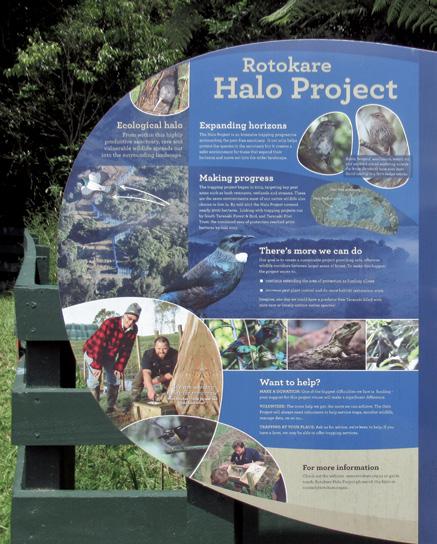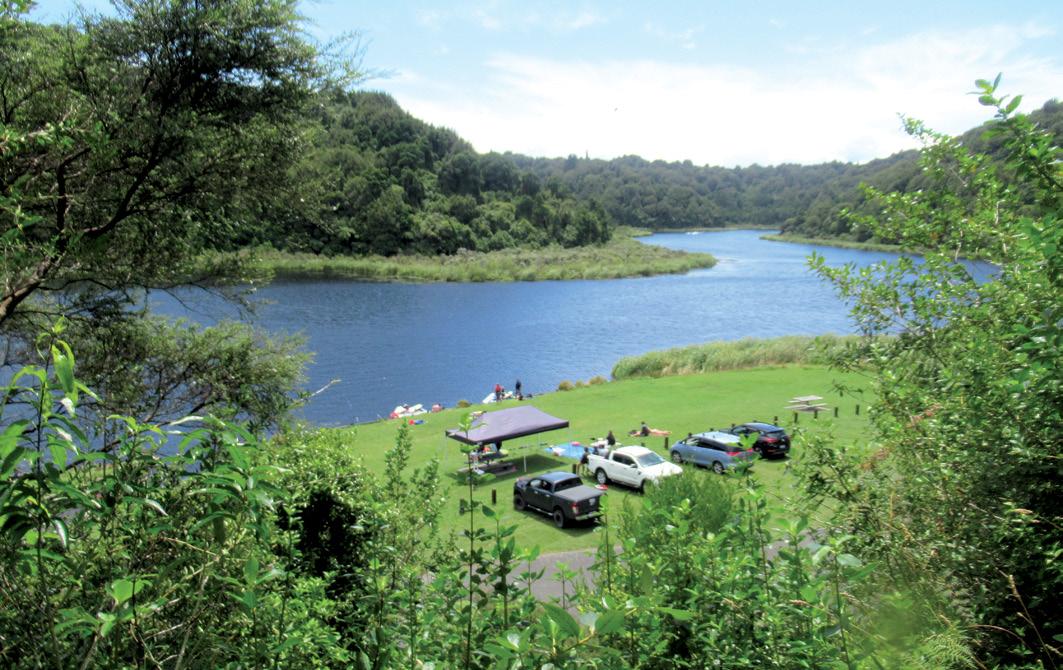
8 minute read
New Zealand Walk: Rotokawa Scenic Reserve
By Judy Eva
Advertisement
Rotokare Scenic Reserve is a community led project, a stunning 230 hectare forested hill country catchment, including extensive wetlands and a 17.8 ha natural lake.
The mature tawa, rewarewa and mahoe dominated forest is home to kiwi, tui, bellbird, kereru, grey warbler and North Island robin plus many other species.
The lake edge habitat consists of raupo, flax and pukatea/kahikatea swamp forest-home to notable fauna such as fernbird, spotless crake, also eels and banded kokopu in the streams and lakes.
Rotokare Scenic Reserve Trust was formed in 2004 by a group of locals concerned that the habitat was in a state of decline. Members of the public became involved as volunteers and sponsors of an intensive pest and trapping programme. This was highly successful in eradicating well over 4,000 pests.
A specially designed predatorproof fence now circles the 8.2 reserve perimeter acting as a barrier to pests immigrating from surrounding farmland. The fence is designed to keep out all species from cats and possums, to rats and baby mice.
It is the largest fenced natural wetland in New Zealand. It offers an exciting environmental education programme to schools, an interactive space with museum type displays and other resources including outdoor environmental experiences by an experienced educator. It is now a community led sanctuary project.
The environment now free of exotic predators is allowing vegeta-
Above: Predator free gate into sanctuary.
Below left: Display along the track of different types of predator traps used..
Below right: Pontoon viewing platform.

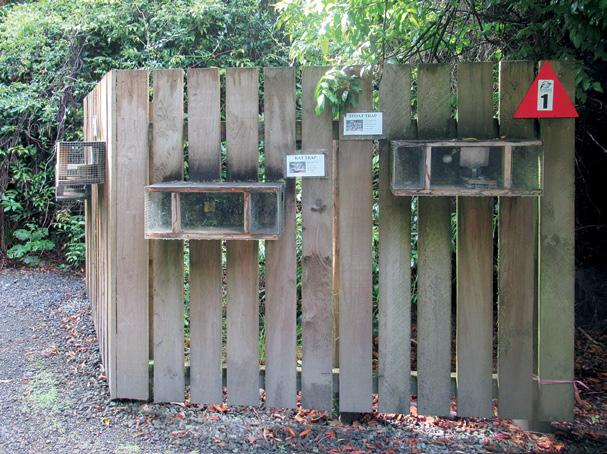

tion to recover and fauna to breed successfully.
In 2012 a Kohanga Kiwi project was established in partnership with Taranaki Kiwi Trust. This now safe and productive habitat allows for many more translocations of rare and endangered species to be returned to the sanctuary into the future.
Rotokare was recognized early in the process of European settlement as a spot of great beauty and value and exists today as a sanctuary of a relatively untouched habitat surrounded by developed farmland. It is set in a basin surrounded by hills giving it a great feeling of being hidden and private.
The lake is fed entirely by natural springs and the only outlet is at the western end of the lake which covers 17.8 hectares and averages six metres in depth together with 212 hectares of surrounding native bush.
The lake is of great importance as a wetland habitat for a range of water bird species, the large amount of aquatic and foreshore vegetation provides an excellent feeding area and shelter for all the different species of these birds.
It also supports short finned and inanga eels.
In 1956 the Eltham County Board was appointed and in 1973 undertook the extension of Sangster Road which now provides sealed access to the lake.
The walk starts at the wonderful Information Centre (learn more about the projects) situated at the second car park. There are brochures available along with photos of the wonderful work the volunteers have contributed to make this sanctuary what it is today.
Heading right from the Information Centre you will come to the beginning of the track into the bush
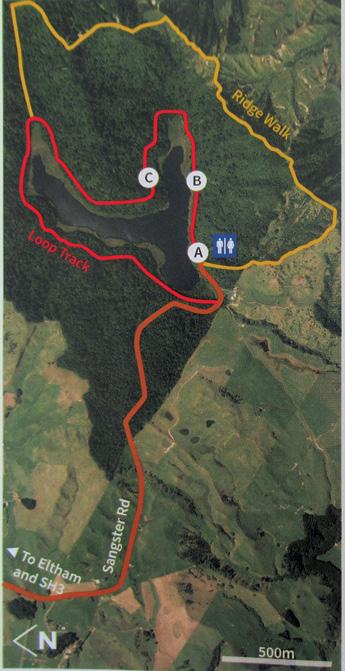
Above: Automatic entry gates into the sanctuary. Below right: There are many boardwalks over the wetlands.
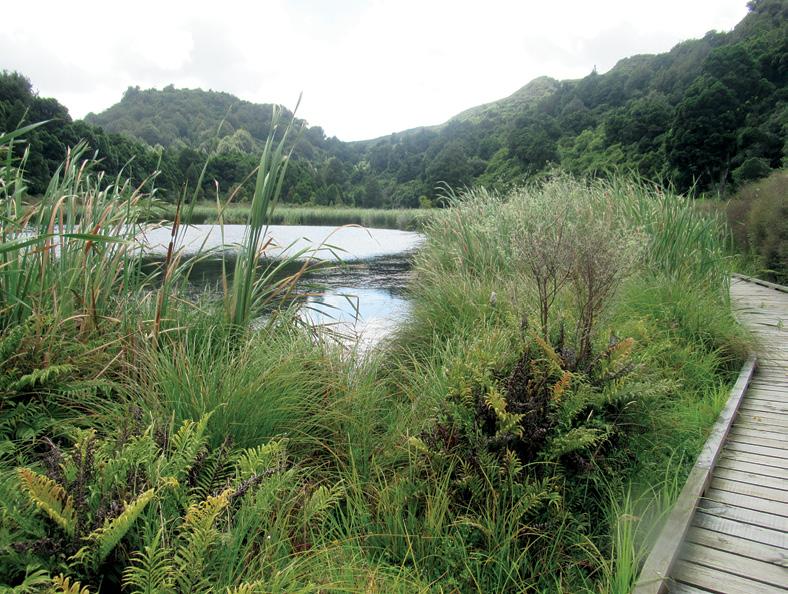
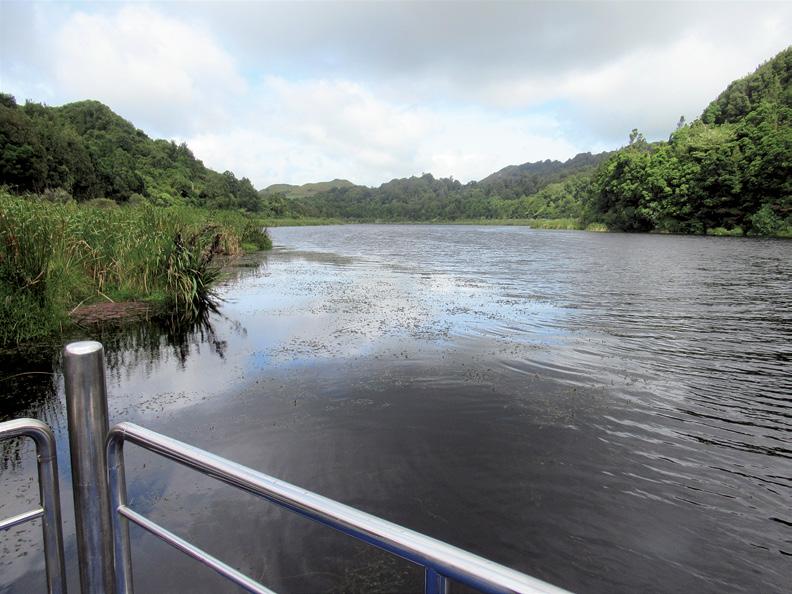
which is well signposted. The lake on your left.
On display just past the entrance to the walk is a stand showing the different types of predator boxes used and set in the bush around the lake. There are large information boards with photos of various bird, animal and flora life to be found along the way also on what species live in the lake.
There was so much to admire on this lovely stroll along the track with views of the lake and as we ventured on we came across a concrete path leading off the main path and down to the lake. This path had embedded into it the names of the volunteers that had given their time, love, sweat and tears to help make this sanctuary what it is today. What a wonderful tribute. How proud they must have been.
There is a pontoon sitting on the edge of the lake that serves as a lookout complete with safety rails and seats and was gently bobbing with the movement of the water. What a great idea to be able view the lake, its inhabitants and across to the other side to where the loop walk winds around the forest.
There are many well constructed boardwalks along the way. The track weaves in and out of bush with lake views and towering pukatea and kahikatea trees and we spotted a few eels and fish in small streams that trickled down under little bridges toward the lake from overflows of water seeping from within the forest floor.
The walkway also takes you through swamp forest crossed by a series of board walks and a canopy of bush and beautiful trees, mosses and native ground cover make the walk interesting and varied. Apparently there are native orchids that are a common sight flowering in autumn and spring depending on the species.
We were followed by young very friendly robin birds that flew down and landed at our feet, not at all nervous of being so close. The cacophony of noise from other species in the trees was just delightful. The track exits at the entrance to the reserve, into the first parking area and onto the road leading back to the Information Centre.
The walk took us two hours and is 4kms long. We took our time. The grade is easy and the track was in good condition. I would advise sturdy boots or shoes as there are muddy areas and I cannot speak highly enough of how beautiful and precious this sanctuary is and just how much blood sweat and tears over the years has been due to dedicated volunteers, members of the public, business firms, The Taranaki Kiwi Trust and all other organizations involved in this wonderful project. The path is wheelchair accessible for 600 meters with lake views, the track then weaves in and out of bush.
The lake, a popular spot for water skiing, is open to powered boats from December to April. It is also popular with canoes and kayaks all year round. There are large grassy areas with picnic tables and toilets and two parking area’s.
We did this walk on a Sunday during the January school holidays and found the noise of two jet boats speeding around the lake quite
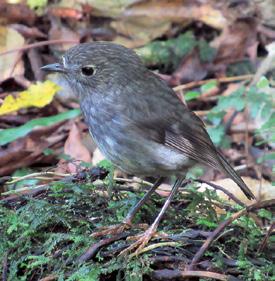
Above left: A view of the lake from the pontoon. Left: A friendly robin at my feet. Below right: A walk in the forest.


disruptive and extremely loud spoiling what would have been a peaceful stroll around this beautiful sanctuary. I guess the inhabitants on land and in the water were not crazy about it either. We were advised by a local couple to do the walk through the week days and not on weekends between December and April, you can then hopefully enjoy the tranquil peace that it really deserves or more chance of doing so.
Lake Rotokare is a predator free zone so check your vehicle or boat and bags for stowaway rodents before entering. Report sightings of pests inside the fence, leave pets at home, take only photographs and leave only footprints. Donations are much appreciated.
The Ridge Walk
There is an adjoining walk in the reserve, The Ridge Walk which apparently is more suited to those that enjoy a challenge. We did not attempt it. It was built by more than 120 volunteers and more than 10,000 nails were used in its construction.
It was a massive job supported by many local business firms and working bee’s. It allows you to see the amazing predator proof fence close up and for beautiful views of the lake before joining the Loop Track via an old bullock track.
The Ridge Walk has 1220 steps, the track is very steep at times and is back country requiring medium to high fit standard. It starts at the Information Centre by the steps, is 6kms and takes three to five hours.
A double gate system allows entry to the Rotokare Reserve. Push the entry button for the gates to open automatically.
Rotokare is located 12ks East of Eltham in South Taranaki at the end Above right: Seats along the way. Below left: Time for a break and chat. Below right: The information board explains the project.
of Sangster Road which is accessible from SH3. Access to the reserve from the Eltham township is King Edward Street, Rawhitiroa Road into Sangster Road or from the Stratford side of Eltham, Anderson Road, into Rawhitiroa Road then into Sangster Road. Most of you now have a GPS which is a great help. Enjoy. GPS 365 Sangster Road Rawhitiroa, Eltham.

